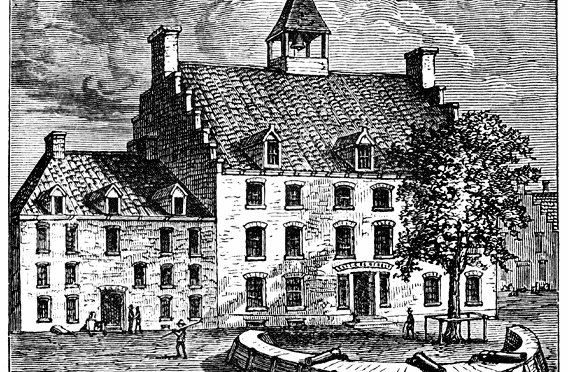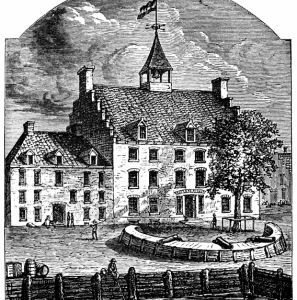New Amsterdam city hall, once one of Manhattan’s very first taverns
McSorley’s Ale House certainly deserves to throw that Old in its title, happily swilling the devil’s juice for 154 years. But it’s positively a youngster compared to evidence of Manhattan’s first two taverns, opened in the days when New York was just barely even New Amsterdam.
Henry Hudson first set eyes on Mannahatta in 1609. Fifteen years later, the Dutch came into New York harbor to begin their permanent settlement. In 1625, work began on Fort Amsterdam, which served as protection from the Indians and as the heart of the developing town. But by that time, New Amsterdam already had a brewery, which began production in 1612!
This young settlement was filled with young traders and shipmen who enjoyed their drink. Their liquor requirement was most likely fulfilled by captains selling it out of their own boats or residents from their own homes. But it’s fur trader Philip Geraerdy that wears the distinction as first private tavern owner. He was granted a lot on “Stone street, between Whitehall and Broad Street,” in 1641 (or possibly 1642, depending on which source you look at) to open his Wooden Horse Tavern (Het Houten Paard).
According to author Mark Caldwell, the name was probably a jab at punishment he had received as a soldier, forced to straddle “two boards nailed together to form a sharp wedge that rested on four legs” due to some sort of subordination.
Geraerdy most likely served no more variety than what can be found at McSorley’s today, ale and possibly wine.
A more official tavern also opened in the same year. Governor of New Amsterdam William Keift had a costly stone structure built at what is today Coenties Slip and Pearl Street and called it City Tavern. Taverns of course were far more than booze dispensaries. They served as inns, meeting halls, social networking places and sometimes even offices. It makes sense then that when the city was incorporated in 1653, City Tavern morphed into what would be New Amsterdam’s very first city hall (Stadt Huys or State House).
By that time, many other taverns had opened with names like Three Small Pigeons and the Blue Grape. In fact, the Dutch brewery business was booming by this time, supplying local ales to Dutch settlements throughout New Netherland.


